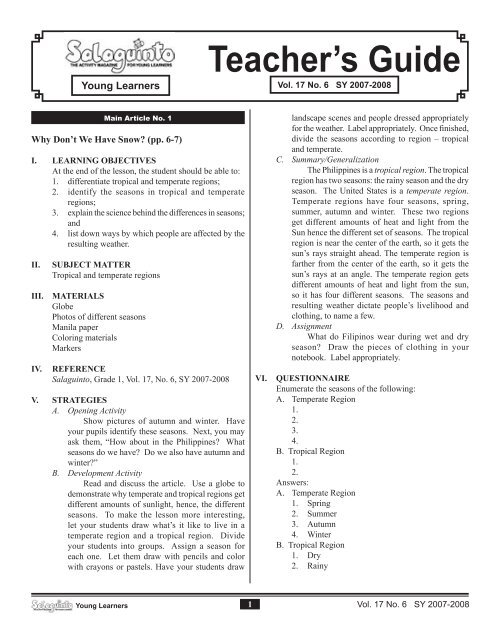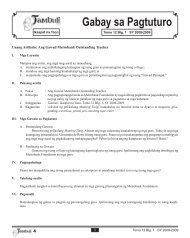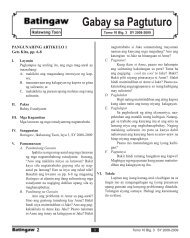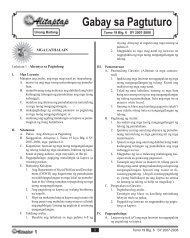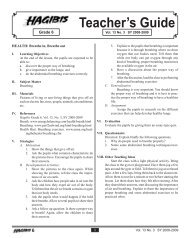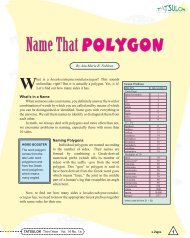Teacher's Guide - Diwa Learning Systems
Teacher's Guide - Diwa Learning Systems
Teacher's Guide - Diwa Learning Systems
Create successful ePaper yourself
Turn your PDF publications into a flip-book with our unique Google optimized e-Paper software.
Young Learners<br />
Young Learners<br />
Main Article No. 1<br />
Why Don’t We Have Snow? (pp. 6-7)<br />
I. LEARNING OBJECTIVES<br />
At the end of the lesson, the student should be able to:<br />
1. differentiate tropical and temperate regions;<br />
2. identify the seasons in tropical and temperate<br />
regions;<br />
3. explain the science behind the differences in seasons;<br />
and<br />
4. list down ways by which people are affected by the<br />
resulting weather.<br />
II. SUBJECT MATTER<br />
Tropical and temperate regions<br />
III. MATERIALS<br />
Globe<br />
Photos of different seasons<br />
Manila paper<br />
Coloring materials<br />
Markers<br />
IV. REFERENCE<br />
Salaguinto, Grade 1, Vol. 17, No. 6, SY 2007-2008<br />
V. STRATEGIES<br />
A. Opening Activity<br />
Show pictures of autumn and winter. Have<br />
your pupils identify these seasons. Next, you may<br />
ask them, “How about in the Philippines? What<br />
seasons do we have? Do we also have autumn and<br />
winter?”<br />
B. Development Activity<br />
Read and discuss the article. Use a globe to<br />
demonstrate why temperate and tropical regions get<br />
different amounts of sunlight, hence, the different<br />
seasons. To make the lesson more interesting,<br />
let your students draw what’s it like to live in a<br />
temperate region and a tropical region. Divide<br />
your students into groups. Assign a season for<br />
each one. Let them draw with pencils and color<br />
with crayons or pastels. Have your students draw<br />
Teacher’s <strong>Guide</strong><br />
Vol. 17 No. 6 SY 2007-2008<br />
landscape scenes and people dressed appropriately<br />
for the weather. Label appropriately. Once finished,<br />
divide the seasons according to region – tropical<br />
and temperate.<br />
C. Summary/Generalization<br />
The Philippines is a tropical region. The tropical<br />
region has two seasons: the rainy season and the dry<br />
season. The United States is a temperate region.<br />
Temperate regions have four seasons, spring,<br />
summer, autumn and winter. These two regions<br />
get different amounts of heat and light from the<br />
Sun hence the different set of seasons. The tropical<br />
region is near the center of the earth, so it gets the<br />
sun’s rays straight ahead. The temperate region is<br />
farther from the center of the earth, so it gets the<br />
sun’s rays at an angle. The temperate region gets<br />
different amounts of heat and light from the sun,<br />
so it has four different seasons. The seasons and<br />
resulting weather dictate people’s livelihood and<br />
clothing, to name a few.<br />
D. Assignment<br />
What do Filipinos wear during wet and dry<br />
season? Draw the pieces of clothing in your<br />
notebook. Label appropriately.<br />
VI. QUESTIONNAIRE<br />
Enumerate the seasons of the following:<br />
A. Temperate Region<br />
1.<br />
2.<br />
3.<br />
4.<br />
B. Tropical Region<br />
1.<br />
2.<br />
Answers:<br />
A. Temperate Region<br />
1. Spring<br />
2. Summer<br />
3. Autumn<br />
4. Winter<br />
B. Tropical Region<br />
1. Dry<br />
2. Rainy<br />
1 Vol. 17 No. 6 SY 2007-2008
VII. EVALUATION<br />
Test your students’ understanding of the topic with<br />
these questions:<br />
1. What region is the Philippines?<br />
2. What seasons do we have?<br />
3. During what season do farmers plant?<br />
Answers:<br />
1. The Philippines is a tropical region<br />
2. We have dry and rainy seasons.<br />
3. Farmers plant during the rainy seasons.<br />
VIII. OTHER TEACHING IDEAS<br />
1. Choose your favorite season. It can even be<br />
something you haven’t experienced yet, like winter.<br />
Write a short poem about this season and explain<br />
why it is your favorite.<br />
2. Read Bill Watterson’s Calvin and Hobbes. Choose<br />
the comic strips depicting the seasons. Your students<br />
will surely laugh at Calvin’s antics as well as get<br />
a whiff of summer, spring, autumn, and winter in<br />
Bill Watterson’s marvelously told snapshots of<br />
childhood.<br />
Young Learners<br />
Main Article No. 2<br />
Cotton Candies in the Sky (pp. 8-9)<br />
I. LEARNING OBJECTIVES<br />
At the end of the lesson, the student should be able to:<br />
1. define clouds;<br />
2. identify different kinds of clouds; and<br />
3. explain what clouds are made of.<br />
II. SUBJECT MATTER<br />
Clouds<br />
III. MATERIALS<br />
Kettle<br />
Water<br />
Stove<br />
Metal Pan<br />
IV. REFERENCE<br />
Salaguinto, Grade 1, Vol. 17, No. 6, SY 2007-2008<br />
V. STRATEGIES<br />
A. Opening Activity<br />
Bring your students outside of the classroom.<br />
Choose a shady, grassy spot and give your students<br />
a few minutes for cloud-watching. Ask: “What do<br />
you think of clouds? What do they remind you of?<br />
What do you think are they made of?”<br />
B. Development Activity<br />
Read and discuss the article. Talk about what<br />
clouds actually are. To demonstrate further, boil<br />
water in a kettle. Hold up a steel pan against the<br />
steam rising from the kettle. Show your students<br />
how the cloudy steam becomes droplets collecting<br />
at the base of the pan that you are holding. This will<br />
show your students that clouds are water droplets<br />
floating in the sky.<br />
C. Summary/Generalization<br />
Clouds are made up of water droplets that are<br />
floating up in the air. They are cool and odorless.<br />
Clouds are just like mists, only they are higher up<br />
in the sky. There are different types of clouds.<br />
Cumulus clouds are clouds that look like cotton.<br />
Stratus clouds are flat clouds that form layers. Cirrus<br />
clouds are clouds that look like hair or soft feathers.<br />
Nimbus clouds are dark and fat clouds that make<br />
rain. When cumulus clouds make rain, they are<br />
called cumulonimbus clouds. When stratus clouds<br />
make rain, they are called nimbostratus clouds.<br />
D. Assignment<br />
Write down the definition of clouds in your<br />
notebook.<br />
VI. QUESTIONNAIRE<br />
1. What are clouds?<br />
2. What are they made of?<br />
3. What clouds make rain?<br />
Answers:<br />
1. Clouds are like mists. They are cool and odorless.<br />
2. They are made of water droplets.<br />
3. Nimbus clouds make rain.<br />
VII. EVALUATION<br />
Test your students’ understanding of the topic with<br />
these questions:<br />
1. What clouds look like soft feathers?<br />
2. What clouds look like cotton?<br />
3. What clouds look flat and come in layers?<br />
Answers:<br />
1. Cirrus clouds<br />
2. Cumulus clouds<br />
3. Stratus clouds<br />
VIII. OTHER TEACHING IDEAS<br />
1. Make models of the different types of clouds using<br />
cotton, water color, glue, and illustration board. Use<br />
markers to make appropriate labels.<br />
2. What forms do you see in clouds? Some people see<br />
rabbits, cotton candy, or castles. Make a fiction story<br />
about clouds.<br />
2 Vol. 17 No. 6 SY 2007-2008
3. Read poems about clouds from well-known writers<br />
of children’s books.<br />
Young Learners<br />
Main Article No. 3<br />
Is It Going to Rain? (pp. 10-11)<br />
I. LEARNING OBJECTIVES<br />
At the end of the lesson, the student should be able to:<br />
1. explain the role of weathermen in society;<br />
2. cite the instruments used by weathermen to tell the<br />
weather; and<br />
3. define PAGASA and what it stands for.<br />
II. SUBJECT MATTER<br />
Weathermen<br />
III. MATERIALS<br />
Newspaper<br />
Photos of weather forecasting instruments<br />
IV. REFERENCE<br />
Salaguinto, Grade 1, Vol. 17 No. 6, SY 2007-2008<br />
V. STRATEGIES<br />
A. Opening Activity<br />
Read a weather forecast from the newspaper.<br />
You may ask your students, “How did the weatherman<br />
know about the weather tomorrow? Is a weatherman<br />
also a magician?”<br />
B. Development Activity<br />
Read and discuss the article. Elicit from your<br />
students that weathermen are not magicians. Rather,<br />
they are scientists. Talk about the instruments used<br />
by weathermen to forecast the weather. Show<br />
pictures of these instruments especially satellites.<br />
C. Summary/Generalization<br />
Weathermen are scientists. Weathermen in<br />
the Philippines work for PAGASA. PAGASA<br />
stands for Philippine Atmospheric, Geophysical<br />
and Astronomical Services Administration. The<br />
instruments they use are thermometers, barometers,<br />
hygrometers, and anemometers to name a few.<br />
A weatherman’s most powerful instrument is the<br />
satellite. It is like a big camera high above that<br />
allows a person to see what is happening in the skies<br />
above the earth. Weather satellites show weathermen<br />
where the big rain clouds are, and where the hot<br />
spots are.<br />
D. Assignment<br />
In your notebook, write down all the instruments<br />
of a weatherman. Define each.<br />
VI. QUESTIONNAIRE<br />
1. What is PAGASA?<br />
2. Is a weatherman also a magician?<br />
3. What is the role of a weatherman?<br />
Answers:<br />
1. PAGASA stands for Philippine Atmospheric,<br />
Geophysical and Astronomical Services<br />
Administration.<br />
2. A weatherman is not a magician. Weathermen are<br />
scientists.<br />
3. Weathermen forecast the weather so that people will<br />
be ready especially in cases of bad weather.<br />
VII. EVALUATION<br />
Test your students’ understanding of the topic with<br />
these questions:<br />
Identify the instruments being described.<br />
_______ 1. Measures wind direction. It tells where the<br />
wind comes from.<br />
_______ 2. Measures air pressure. It tells if a storm is<br />
approaching.<br />
_______ 3. Measures humidity. It tells how much water<br />
vapor is in the air.<br />
_______ 4. Measures temperature. It tells how hot or<br />
cold it is.<br />
_______ 5. A device launched into space to orbit the<br />
Earth. Collects data about weather.<br />
Answers:<br />
1. Anemometer<br />
2. Barometer<br />
3. Hygrometer<br />
4. Thermometer<br />
5. Satellite<br />
VIII. OTHER TEACHING IDEAS<br />
1. Watch a documentary about satellite technology.<br />
2. How did the people forecast the weather before<br />
weather instruments were invented? Some people<br />
can tell the weather even without using elaborate<br />
instruments. Ask your mom and dad about it.<br />
3. Old folks have some funny superstitions about the<br />
weather. See if they are facts or myths. Ask your<br />
grandparents about their old beliefs about weather.<br />
Main Article No. 4<br />
Why Is the Lake Dead? (pp. 12-13)<br />
I. LEARNING OBJECTIVES<br />
At the end of the lesson, the student should be able to:<br />
1. identify environmental abuse and its causes;<br />
2. define acid rain and air pollution;<br />
3 Vol. 17 No. 6 SY 2007-2008
3. develop earth-friendly habits; and<br />
4. advocate for protection of the environment.<br />
II. SUBJECT MATTER<br />
Acid Rain and Air Pollution<br />
III. MATERIALS<br />
Paper<br />
Pen<br />
IV. REFERENCE<br />
Salaguinto, Grade 1, Vol. 17, No. 6, SY 2007-2008<br />
V. STRATEGIES<br />
A. Opening Activity<br />
You may ask your students, “Have you ever<br />
seen a dead lake or a dirty pool of water? Describe<br />
how it looks like.”<br />
B. Development Activity<br />
Read and discuss the article. Elicit from<br />
your students the problems cited in the article.<br />
Write cause and effect. For example, because of<br />
indiscriminate logging, a mudslide occurred. This<br />
mudslide resulted in the lake filling up with soil and<br />
the fish dying. Trace back the source of the problem.<br />
<strong>Guide</strong> your students in realizing that humans are the<br />
culprit in abuse of the environment. And if humans<br />
are the culprit, what then should be done about it?<br />
Have a discussion.<br />
C. Summary/Generalization<br />
Man has been most indiscriminate in his<br />
activities. Illegal logging has led to mudslides<br />
and death. Forests have been cut down with very<br />
few trees left standing. Bountiful lakes are dead<br />
or dying. Acid rain caused by air pollution from<br />
industry exhaust now fall from the sky. It poisons<br />
bodies of water and causes respiratory damage to<br />
people. People must change their ways and promote<br />
earth-friendly habits. Stopping air pollution is one<br />
of the ways which we can protect the earth and<br />
ourselves.<br />
D. Assignment<br />
Come up with 10 Earth-friendly habits in your<br />
notebook. Be sure to follow them.<br />
VI. QUESTIONNAIRE<br />
List the results of man’s abuse of his resources.<br />
Possible Answers:<br />
1. Floods<br />
2. Mudslides<br />
3. Dead lakes or dead bodies of water<br />
4. Acid Rain<br />
Young Learners<br />
5. Polluted Air<br />
6. Sickness and disease<br />
VII. EVALUATION<br />
Test your students’ understanding of the topic with<br />
these questions:<br />
1. In the story, why were there were very few trees in<br />
the area?<br />
2. What killed the fish in the lake?<br />
3. Why can rain sometimes be dangerous?<br />
Answers:<br />
1. The trees were cut down by illegal loggers.<br />
2. The fish were killed by acid rain. Also, the soil from<br />
the mudslide filled up the lake.<br />
3. Acid rain looks, feels, and tastes like clean rain. But<br />
the pollutants in acid rain, when inhaled, can damage<br />
the lungs<br />
VIII. OTHER TEACHING IDEAS<br />
1. Have a tree-planting activity. Name your trees after<br />
your students. They can water these every day after<br />
class.<br />
2. Make Save the Earth posters. Post these around the<br />
school. You can also make bookmarks and give them<br />
out to friends and family.<br />
Regular Features<br />
Story for the Young: The Super Outbreak (pp. 3-4)<br />
Watch a movie with a tornado in it. Twister is a good<br />
movie that depicts tornadoes. Observe the intensity of it and<br />
identify where it belongs in the Fujita Scale. If you have the<br />
resources, watch a documentary about tornadoes. You can<br />
also access YouTube.com and see clips of actual tornadoes in<br />
different countries.<br />
I am <strong>Learning</strong>: Tornado Trail (p. 5)<br />
Josh is playing a game. He needs to trace the path of a<br />
tornado. To do this, he should identify which statements below<br />
the objects are telling the truth. Help Josh find the tornado<br />
trail. Color the object GREEN if it is telling the truth. Color<br />
the objects RED if it is not telling the truth. Then, connect the<br />
green objects to show the tornado trail to Josh.<br />
Earth Care: Hot and Cold Go Green (pp. 14-15)<br />
Join Teacher Sarah’s game! Write your own list on how to<br />
save the Earth on both hot and cold days. Share these tips with<br />
your family members so you can also follow these at home.<br />
My Hands at Work: Spot an Acid (pp. 16-17)<br />
Find acid in your everyday food. Collect the materials<br />
needed for the experiment. Follow the instructions and observe<br />
4 Vol. 17 No. 6 SY 2007-2008
what happens. Draw your own conclusions. Marvel at the<br />
science behind.<br />
Let’s Play a Game: Weather Wonders/Kyle’s Closet (p.<br />
18-19)<br />
Here are two games you can play with your students. Get<br />
out your crayons for a coloring and mind exercise. These games<br />
will help you find out how much your students learned from<br />
this issue of Salaguinto.<br />
Read and Answer: Winter in Batanes (p. 20-21)<br />
Winter in Batanes, Philippines? Read the article to find<br />
out why the title of the article is so. Have volunteers act out<br />
the dialogue in the article. Elicit from your students what they<br />
have learned from reading the story.<br />
In Real Life: Be Prepared (p. 22)<br />
The article teaches us to always be prepared. We have<br />
different things to be prepared about. Ask your students to write<br />
down 3 things that they need to prepare for in their future. To do<br />
this, they will need to identify their long term goals early on.<br />
Fun Time: Earth Care Tips (p. 23)<br />
It is important to take care of earth. Color the picture that<br />
shows how to take care of earth. Then identify if the picture<br />
shows an earth care tip for a hot day or cold day. Write your<br />
answers in the blanks.<br />
Mindgames: Picture Perfect (p. 24)<br />
Candy will show her friends what she learned about the<br />
weather. She collected cutouts of different pictures. She wants<br />
to label each picture. Help Candy label the pictures. Check out<br />
the pictures on the page. Encircle the correct word to complete<br />
the label.<br />
ANSWERS TO THE ACTIVITY<br />
MAIN ARTICLE 1: Why Don’t We Have Snow? (pp. 6-7)<br />
The colored liquid will move up the straw when the bottle<br />
is warmed. Hands have heat that can warm the bottle.<br />
MAIN ARTICLE 2: Cotton Candies in the Sky (pp. 8-9)<br />
Cloud number 4 should be colored gray. It is not telling the<br />
truth about clouds. Stratus clouds are not fat and dark. Stratus<br />
clouds are flat and come in layers.<br />
MAIN ARTICLE 3: Is It Going to Rain? (pp. 10-11)<br />
Make a weather journal and use a thermometer to measure<br />
differences in temperature for a week.<br />
Young Learners<br />
MAIN ARTICLE 4: Why Is the Lake Dead? (pp. 12-13)<br />
1. Mudslide- No more trees to hold soil<br />
2. Air pollution- Smoke from cars and factories<br />
3. Poisoned water- Acid rain<br />
I am <strong>Learning</strong>: Tornado Trail (p. 5)<br />
The following statements should be colored GREEN. They<br />
are telling the truth.<br />
1. Meteorologists are people who study the weather.<br />
3. The Fujita scale is based on the damage of a tornado.<br />
4. An F5 tornado is called Incredible tornado.<br />
6. An F4 tornado is called Devastating tornado.<br />
The following statements should be colored RED. They<br />
are not telling the truth.<br />
2. There were 148 tornadoes during the Super Outbreak in<br />
April 1979. (April 1974)<br />
5. Tornadoes do not happen in the Philippines.<br />
Tornado Trail:<br />
JOSH<br />
2<br />
<br />
5 <br />
TORNADO<br />
Let’s Play a Game: (p. 18-19)<br />
Weather Wonders (p.18)<br />
The following should be encircled using color green- Thermometer<br />
(temperature), hygrometer (humidity)<br />
The following should be encircled using color red- Barometer<br />
(air pressure), anemometer (wind direction)<br />
Solve This- Weather journal<br />
Kyle’s Closet (p. 19)<br />
The following objects should be colored BLUE (used<br />
during wet or rainy day)-<br />
Raincoat, boots, jacket, umbrella<br />
The following objects should be colored YELLOW (used<br />
during hot or dry days)-<br />
Shirt, sunglass, hat<br />
Read and Answer: Winter in Batanes (p. 20-21)<br />
1. What are the people who live in Batanes called? - The<br />
people who live in Batanes are called Ivatan.<br />
2. When does “winter” happen in Batanes? – Winter does not<br />
happen in Batanes, but cool weather, which the people call<br />
winter. This happens in the months of July to February.<br />
3. What’s the weather in Batanes during the months of July<br />
to February? – The weather in Batanes during the months<br />
of July to February is cool.<br />
4. Why is Batanes often mentioned in a weather report?<br />
- Weather forecasters use information from the weather<br />
station in Batanes.<br />
5 Vol. 17 No. 6 SY 2007-2008
Fun Time: Earth Care Tips (p. 23)<br />
All pictures should be colored. They show earth care tips.<br />
Then the following labels should be placed on the blanks below<br />
each picture.<br />
1. picture/illus of a father cleaning the windows<br />
Cold day<br />
2. picture/illus of a young boy using an abaniko<br />
(pamaypay)<br />
Hot day<br />
3. picture/illus of a mother turning off an electric fan<br />
Cold day<br />
4. picture/illus of a young girl turning off the light<br />
Hot day<br />
Mindgames: Picture Perfect (p. 24)<br />
1. Bulacan<br />
2. Xenia<br />
3. paper<br />
4. Batanes<br />
Young Learners<br />
6 Vol. 17 No. 6 SY 2007-2008


